Future of TV Briefing: 8 charts that sum up the state of streaming advertising

This Future of TV Briefing covers the latest in streaming and TV for Digiday+ members and is distributed over email every Wednesday at 10 a.m. ET. More from the series →
This week’s Future of TV Briefing takes a visual look at the state of streaming ads.
- Data stream
- Olympics increase streaming watch time
- Fubo vs. Venu, animators v. AI, Byron Allen vs. bills and more
Data stream
The dog days of August are as good a time as any to step back and assess the state of things. And there have been a number of recent studies surrounding the TV, streaming and video ad landscape that seem to lay out the current conditions. So here’s a selection of charts that sum up the situation.
Streaming has reached critical mass
Virtually every household in the U.S. is streaming videos, movies and shows these days. To put a number on it, 96% of U.S. households – a.k.a. 124 million households – are streaming, according to Kantar.
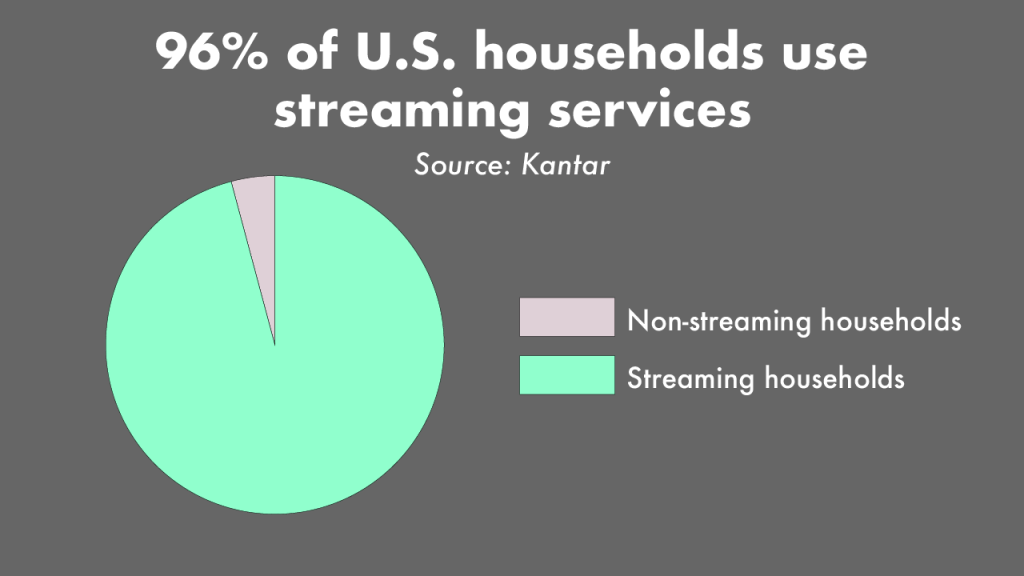
Viewership is skewing toward ad-supported
Historically, streaming has been a largely ad-free viewing experience. But as more streamers have introduced ad-supported tiers to supplement revenue, a lower percentage of viewers are tuning into ad-free services. And Amazon Prime Video’s ad-supported entry earlier this year has coincided with a sharp decline in ad-free viewing, according to Hub Entertainment Research.
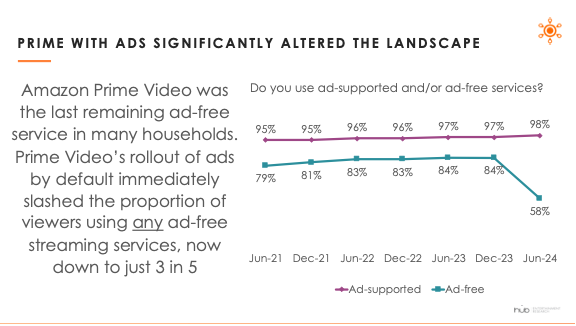
Streaming is drawing ad dollars away from traditional TV
Streaming’s saturation and ad-supported spurt have naturally made it more attractive to advertisers, which are primarily diverting dollars from traditional TV, according to a study Advertiser Perceptions conducted for Premion.

But streaming is still only a slice of advertisers’ overall video budgets
This year advertisers in the U.S. are expected to spend $62.9 billion on digital video ads, according to the 2024 IAB Digital Video Ad Spend & Strategy Report. But streaming – which the report confoundingly labels “CTV” and defines as “TV-like, Internet-delivered content” – will only receive 36% of that spending. (Of course, that share would likely be higher if YouTube were included in the “CTV” category instead of “social video.”)

Because (in part) advertisers don’t have enough control over their streaming campaigns
Fragmentation takes the fall for why advertisers’ streaming spend is somewhat inhibited. Per Advertiser Perceptions/Premion, ad delivery transparency, streaming fragmentation and frequency management are the top challenges facing streaming advertisers – and inconsistent measurement and inconsistent reporting are the next two biggest challenges.
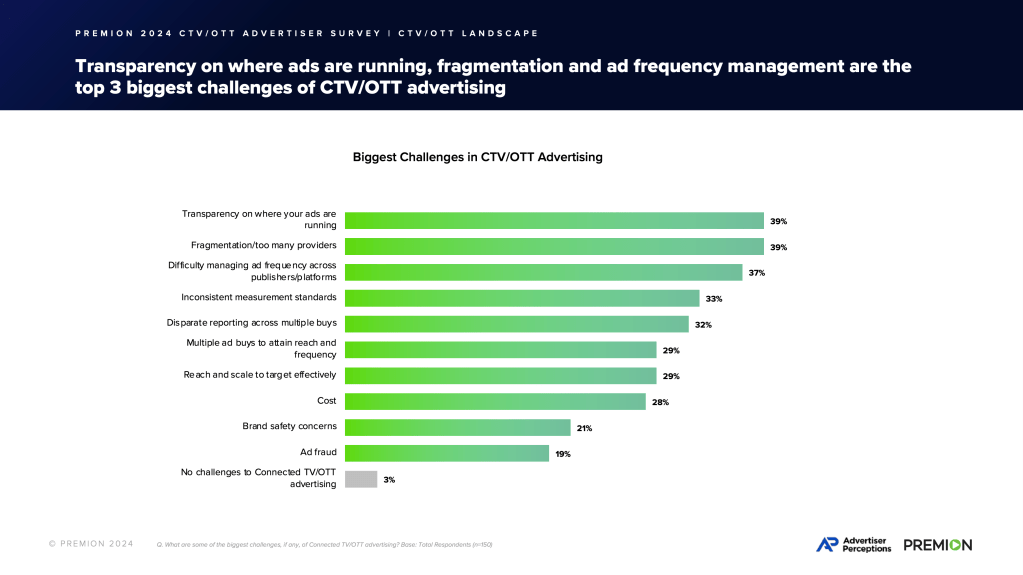
In fact, advertisers are either annoying or ignoring viewers
For as much as ad-supported streaming viewership has grown and is growing, advertisers are too often missing the enlarged mark. An overwhelming majority of TV and streaming ad impressions – 94% – are being served to the top 50% of U.S. households that spend the most time watching traditional TV, according to Samba TV. And yes, that’s based on households’ traditional TV watch time, but it includes streaming ad impressions. By contrast, only 6% of TV and streaming ads reached the bottom 50% of households.
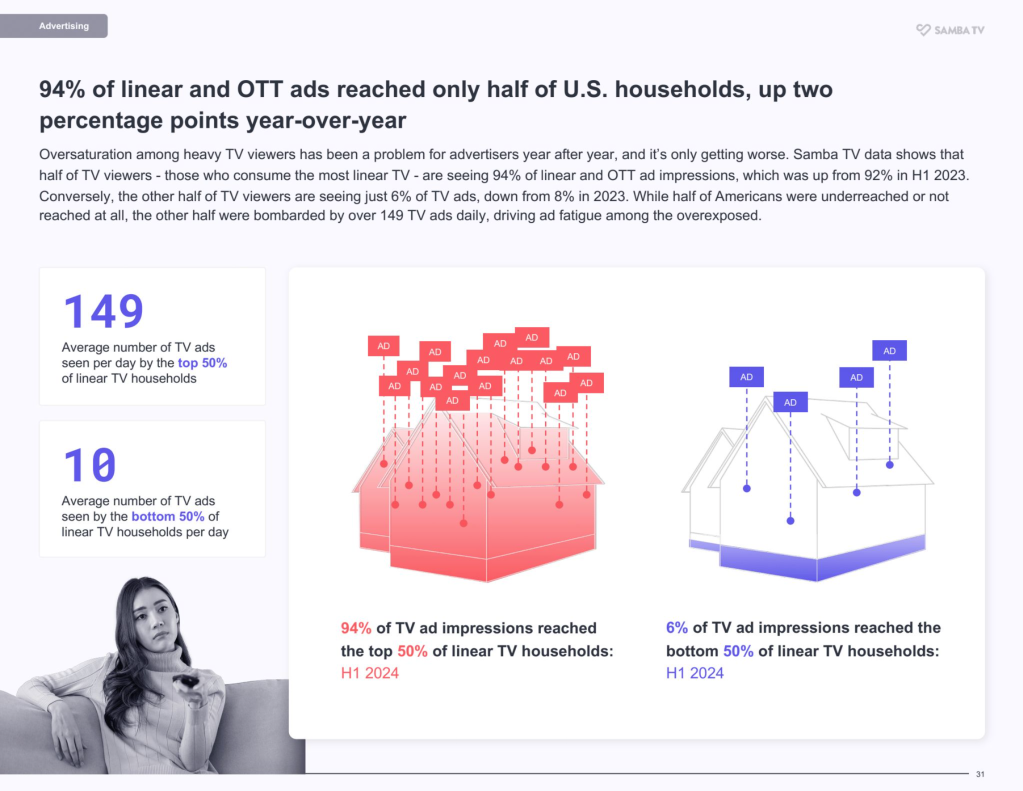
Streaming ad buying methods are evolving
A lot of the aforementioned issues seem symptomatic of a marketplace that’s underdeveloped. These issues are not alien to traditional TV advertising, but streaming is digital, and digital is supposed to be smarter. Enter programmatic, which is becoming a more primary way that advertisers are purchasing streaming inventory, according to Advertiser Perceptions/Premion.
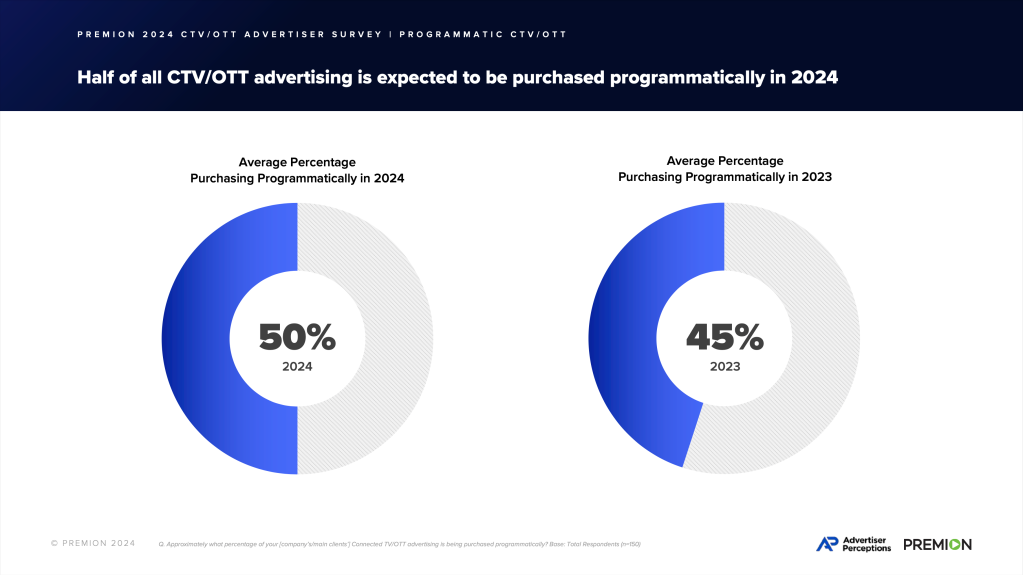
But will programmatic alleviate or exacerbate these issues?
Ostensibly, programmatic buying methods would help with managing frequency and fragmentation if advertisers are able to consolidate their buying to one or a few demand-side platforms in order to control their campaigns. And that’s particularly true when advertisers are opting for more controlled programmatic buying paths, like private marketplaces and programmatic guaranteed deals. But per the IAB report, half of streaming ad transactions this year are set to go through either ad networks or open exchanges, which aren’t exactly known for transparency and control.
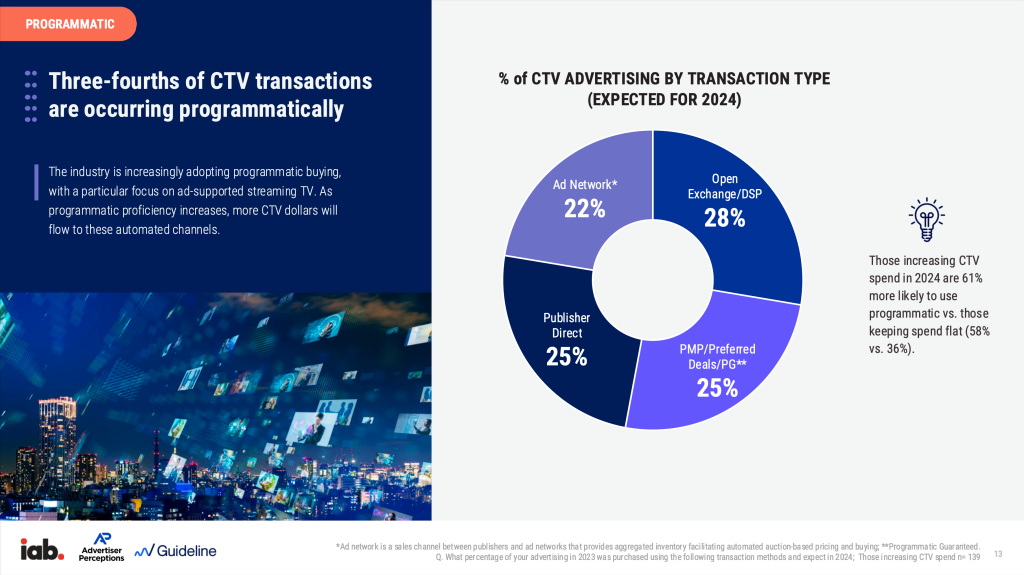
What we’ve heard
“There needs to be an AI clause and creators need to make sure that that’s covered in there.”
— Team One brand partnerships and culture director Lindsay Calabrese on AI and influencer marketing
Olympics increase streaming watch time
The Olympics only aired for six days in July, but that was enough to affect the amount of time people spent watching TV last month. And the biggest boost came to streaming, which reached a record high share of TV watch time, according to Nielsen’s latest The Gauge viewership report.

While streaming was the biggest recipient of the Olympics interest, traditional TV did also benefit. “When TV usage is isolated by week, the start of Olympics coverage in the final week of July pushed the broadcast average up to over 22% of total TV,” according to Nielsen.
But again, streaming was the bigger beneficiary. Look no further than Olympics rights holder NBCUniversal and the 0.3 percentage point share increase it notched in the month. OK, 0.3 percentage points sounds somewhat minimal, but that tied Amazon Prime Video for the second-biggest gain of any streamer in July. The biggest gainer? YouTube, which stretched its lead as the streamer with the most watch time past the 10% threshold.
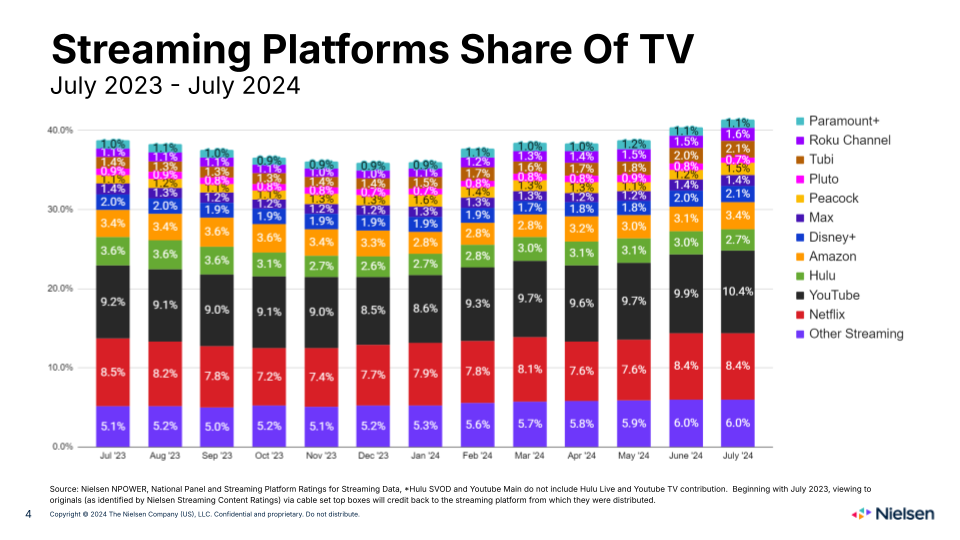
Numbers to know
150%: Year-over-year increase in upfront ad commitments that Netflix secured during this year’s negotiations.
$4.3 billion: How much money Edgar Bronfman Jr. is willing to pay to acquire Paramount away from Skydance Media.
$9.42: How much money pay-TV providers pay Disney per subscriber to carry ESPN.
$170 million: How much money Kamala Harris’s campaign has reserved to spend on TV ads between Labor Day and Election Day.
>70%: Percentage share of Spotify’s video podcast audience that watches the videos in the foreground.
$0.9 billion: How much money people spent on short-form video apps in the first quarter of 2024.
What we’ve covered
TikTok moves ahead of YouTube for brands’ video-focused social media marketing:
- 67% of brand and retail professionals polled by Digiday+ Research posted content on TikTok in the past month.
- 60% posted content on YouTube in the same timeframe.
Read more about social video marketing here.
As sports enjoys a moment, buyers find new ways to get in via influencers and CTV:
- Streaming sports has opened up inventory to new advertisers.
- Athletes are available for influencer marketing deals (a.k.a. sponsorships and endorsements).
Read more about advertisers’ sports spending here.
AI hype sparks influencer contract overhauls for name, image and likeness:
- One creator is asking clients to agree not to train her voice on any AI technology.
- AI is part of a broader focus on content usage rights in influencer deals.
Read more about influencers’ AI contract terms here.
As the presidential election approaches, where do influencers come in?:
- Last week the White House hosted a summit for creators.
- This week the Democratic National Convention has given media credentials to creators.
Read more about influencers and election season here.
As political ad spend faucet opens, CTV media stands to be a major winner:
- Political ad spending had reached $385 million as of Aug. 8.
- Democrats are outspending Republicans so far.
Read more about political campaigns’ CTV ad spend here.
What we’re reading
Disney’s, Fox’s and Warner Bros. Discovery’s streaming sports joint venture won’t be able to launch, a judge ruled, until streaming pay-TV provider Fubo’s lawsuit against the companies is resolved, according to Bloomberg.
AI is once again a front-and-center issue as another Hollywood union — The Animation Guild — enters negotiations with film and TV studios, according to The Hollywood Reporter.
The Screen Actors Guild has signed a deal with AI company Narrativ so that the former’s members can have the latter’s AI trained on their voices in order to generate voiceovers for advertisers while compensating the actors, according to Variety.
The media mogul — who has tried to buy ABC, BET and Paramount in the past year — has been late in paying the TV network owners that carry Allen Media Group’s local TV stations, according to CNBC.
Want to discuss this with our editors and members? Join here, or log in here if you're already a member.
More in Future of TV

Future of TV Briefing: A preview of Digiday’s CTV Advertising Strategies event
This week’s Future of TV Briefing previews next week’s CTV Advertising Strategies event that I’ll be hosting with top brand and agency executives in New York City.

Future of TV Briefing: TV is YouTube’s top screen — except when counting views and among Gen Z viewers
This week’s Future of TV Briefing looks at how mobile still accounts for an overwhelming majority of YouTube video views and why some Gen Z viewers aren’t tuning into YouTube on TV screens.

YouTube vs. TikTok vs. Instagram: What Gen Z really watches in 2025
At VidCon 2025, more than a dozen Gen Z attendees weighed in on the video apps they are most and least likely to watch.








